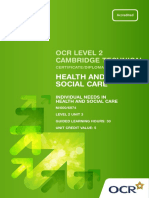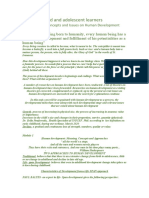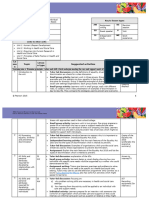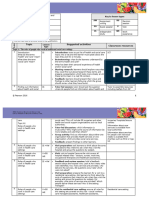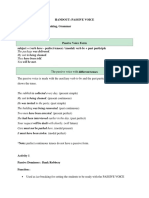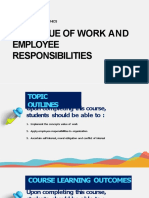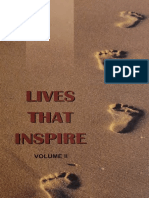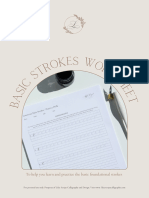BTEC NATIONAL HEALTH AND SOCIAL CARE
UNIT 1: HUMAN LIFESPAN DEVELOPMENT
Unit 1: Human Lifespan
Unit title Key to lesson types
Development
Guided learning AW Assignment RS Revision
90
hours writing session
Number of GS Guest speaker V Visit
45
lessons
Duration of IS Independent WE Work
2 hours
lessons study experience
Links to other units
This unit has links to all other units in the qualification.
Lesson
Topic Suggested activities Classroom
Lesson type
resources
Topic A: Human growth and development through the life stages
1 Understand human IS Tutor presentation: Start of unit with an introduction to human Textbooks
development development. Paper, pens
Define the terms Individual activity/small group activity: Learners will be
growth; development; required to use books to look up definitions of terms relating to
developmental norms; Growth & Development. Then 4 areas of development (PIES)
developmental introduced with activity – group work to look at the areas of
milestones; life course; development and lifestages.
maturation and life
expectancy
Identify and describe 4
areas of development
and lifestages
© Pearson 2016 1
�BTEC NATIONAL HEALTH AND SOCIAL CARE
UNIT 1: HUMAN LIFESPAN DEVELOPMENT
2 Define the term IS Tutor presentation: An overview of foetal development to be Textbooks
conception given. Paper, pens
Outline the stages of Class discussion: Lead discussions about potential causes and
foetal development effects of delayed and arrested development during foetal
Discuss potential causes development.
and effects of delayed Individual activity:
and arrested o As an introduction to human development, first ask learners
development during
to think of a person; either themselves, a family member or a
foetal development
celebrity.
o Then ask them to write an introduction about the creation of
their life, conception and foetal development.
o They will also choose one possible development delay or
disability for each life stage.
3 Analyse developmental IS Paired activity/group activity: Activity using a plastic cup, Plastic cups
skills in relation to flour, salt and water to be done first. Learners will be making Flour
holistic development dough from these ingredients only – their task is work out how
to do this only using a cup, flour, salt and water. They will then Salt
analyse the developmental skills they have used to do this. This Jugs
will establish their understanding of existing developmental skills Water
so that they can begin to understand how they are developed
and why they are needed. Cleaning
materials
4 Discuss developmental IS Individual activity: Learners create a spider-gram of Textbooks
skills and the development based on the activity that was carried out. Paper, pens
importance of holistic Teacher presentation/teacher-led discussion: Recap and
development briefly give an overview of key theorists as this will be revisited
Identify key theorists in later in the unit in more detail. The learners will be shown some Genie Wiley
relation to development clips of Genie Wiley and questioned about it. clip (Internet
based)
5 Identify and explain IS Class discussion/small group activity: Discussion on infancy Textbooks
patterns of holistic and patterns of development. Small group work used to explore Paper, pens
development in infancy an overview of development.
© Pearson 2016 2
�BTEC NATIONAL HEALTH AND SOCIAL CARE
UNIT 1: HUMAN LIFESPAN DEVELOPMENT
Identify development
present at birth
Identify and explain
reflexes
6 Explain the patterns of IS Individual activity: Learners to map the birth to infancy Textbooks
growth and development lifestage of their chosen person (e.g. favourite celebrity) to show Paper, pens
during infancy and make growth and development patterns.
links to theories of
development
7 Analyse developmental IS Individual activity: Learners create a spider-gram of Textbooks
skills in relation to development based on the activity that was carried out. This will Paper, pens
holistic development be recapped and an an overview of key theorists given as this
will be revisited later in the unit in more detail. The learners will
be shown some clips of Genie Wiley again and more deeply Genie Wiley
questioned about it. clip (Internet
Tutor-led discussion: Questioning will take place before based)
looking at key theorists.
8 Discuss developmental AW Tutor-led discussions/small group activity: Questioning Textbooks
skills and the based session involving small and large group work. Looking at: Paper, pens
importance of holistic o How important is development?
development
o Do you think that development is biological (it is going to
happen because we are pre-programmed to be intelligent or
to be badly behaved)?
o Or do you think that development requires external
influences? If so, why?
9 Explain the patterns of IS/GS Individual activity: Learners to create a timeline of Textbooks
growth and development developmental milestones during the session. The timeline will
during infancy and make support their assessment.
links to theories of Pens, paper
Guest Speaker: Possible guest speaker – health visitor.
development
© Pearson 2016 3
�BTEC NATIONAL HEALTH AND SOCIAL CARE
UNIT 1: HUMAN LIFESPAN DEVELOPMENT
10 Analyse the value of IS Small group activity: Learners will participate in play to Pens, paper
play and explain the analyse the value of play for children.
importance of play in Small group activity: They will work in groups to build and
child development Drinking
construct a given task. Learners will have to work as a team. straws and
They will then analyse the skills they used and the blu-tack
developmental areas children could potential develop through a
play activity to link their understanding of how growth and
development occurs during childhood.
11 Identify and explain the IS Tutor-led discussion: Learners to be given information about
patterns of development the theory of child development, to be combined with a class
during childhood discussion to draw on learners’ own experiences.
12 Create a resource, e.g. IS Individual activity: Learners will then create a childhood Textbooks
timeline clearly showing timeline or graphical organiser (resource) to consolidate what Paper, pens
holistic development they have learnt. Learners will include all previously studied
during childhood aspects and will select what they feel are the most important
aspects of holistic development during childhood.
13 Explain the importance IS Tutor-led discussion: Through tutor input, learners will come Textbooks
of secondary to understand and identify the PIES in relation to adolescence. Paper, pens
socialisation and peer They will be able to discuss the significance of secondary
pressure socialisation and peer pressure – minimal links are made to key
Introduction to theorists.
adolescence
14 Identify and describe IS Individual activity: Learners will create an adolescence Textbooks
physical areas of timeline or graphical organiser (resource) of their choice to Paper, pens
puberty (differences consolidate what they have learnt. Learners will use information
between male & female) gained during the session and textbooks to help them complete Computer
this task. Learners will select what they feel are the most access for
Create a timeline of research
development in important aspects of holistic development during adolescence to
adolescence create their timeline or organiser.
15 Research and create a IS Individual activity: Learners will be researching a chosen Textbooks
fact file of a chosen celebrity and they will produce a fact file about the individual Paper, pens
© Pearson 2016 4
�BTEC NATIONAL HEALTH AND SOCIAL CARE
UNIT 1: HUMAN LIFESPAN DEVELOPMENT
celebrity they have chosen. This fact file will include biographical data and Computer
PIES related information regarding the chosen celebrity. access for
research
16 Identify the PIES in IS Tutor-led discussion: Give learners the information they need Textbooks
relation to adulthood to understand and identify the PIES in relation to adult Paper, pens
adulthood.
Small group activity: A poster will be created in small groups
to display this information.
NB You may wish to link this to the activity listed in lesson 18.
17 Discuss the significance IS Small group activity: Learners to discuss the significance of Textbooks
of how age can reverse how age can reverse areas of development in some people. To Paper, pens
certain areas of occur in small groups and be fed back to the whole group.
development in some
people
18 Identify the PIES in IS Tutor-led discussion: Provide learners with the information Textbooks
relation to later they need to understand and identify the PIES in relation to later Paper, pens
adulthood adulthood.
Small group activity: A poster will be created in small groups
to display this information.
Class discussion: Discussion to follow with later adulthood and
final stages of life.
19 Positives of later IS Learners will discuss the merits of later adulthood. Textbooks
adulthood The purpose of the session is to challenge the commonly held Paper, pens
belief that later adulthood is an entirely negative lifestage.
20 Recap of development RS Individual activity: Using timelines and posters created in Textbooks
through the life stages previous sessions, learners will create a revision file for Paper, pens
development through the life stages.
Timelines,
graphical
organisers,
© Pearson 2016 5
�BTEC NATIONAL HEALTH AND SOCIAL CARE
UNIT 1: HUMAN LIFESPAN DEVELOPMENT
posters
Topic B: Factors affecting human growth and development
21 Discuss the nature- IS Tutor-led discussion: Discussion about the nature-nurture Video of
nurture debate in debate following an opening video clip about children who socially
relation to an individual allegedly grew up in unfortunate circumstances. caused
Small group activity/plenary: This will break out into smaller developmental
groups and come back together for plenary session. delay
Pens, paper
22 Identify key theorists IS Small group activity: groups to be given a case study and Theorist
and discuss their information sheet about developmental theorists. Their task is to factsheets
arguments in relation to discuss the nature-nurture debate in relation to the individual. Pens, paper
the debate
23 Evaluation of how nature IS Tutor-led discussion: Learners to be given help to evaluate Previous
and nurture may affect how nature and nurture may affect the physical, intellectual, nature/nurtur
development emotional and social development of two stages of the e notes
development of an individual in study buddy pairs. Case study
Pens, paper
24 Define the term factor IS Individual activity/paired activity: Learners to work Paper, pens,
Identify different life individually, then in pairs, then work in small groups to identify a mini
factors that affect range of factors that could affect development, finally feeding whiteboards
development back to whole group.
25 Explain potential effects IS Tutor presentation/individual activity: Learners will be given Genetic
of different life factors information about genetic conditions then they will use the condition
on the development of information to choose one and write about it in relation to the factsheets
the individual (genetic development of the individual. Pens, paper
factors)
26 Explain the difference IS Tutor-led discussion: Discussion to explore genetic and Information
between genetic and biological factors. Learners must understand that genetic means on genetic and
biological factors something that is inherited, whereas biological refers to biological
something that is passed on from maternal factors (during conditions
© Pearson 2016 6
�BTEC NATIONAL HEALTH AND SOCIAL CARE
UNIT 1: HUMAN LIFESPAN DEVELOPMENT
Identify biological pregnancy). Pens, paper
factors
27 Explain potential effects GS Tutor-led discussion: Learners to revisit factors they identified Notes from
of different life factors in last session to look at what they think could occur during last sessions
on the development of pregnancy and how. Pens, paper
the individual Guest speaker: Possible guest speaker – health visitor, social
(biological) worker.
28 Identify lifestyle factors IS Tutor-led discussion: Learners to be asked to identify lifestyle Change for life
Identify reasons why a factors. information
healthy diet is important Encourage learners to think about why a healthy diet is packs
in relation to important. Resources to be included for visual purposes. Pens, paper
development Learners to think about smoking and substance misuse and the
Identify and explain how effects on an individual through a brainstorm activity and class
diet related illnesses discussion.
could affect
development
29 Identify and explain the RS Paired activity: In pairs, learners will choose one lifestyle factor Previous notes
effects of smoking, and create a mind map showing the effects of their factor and Pens, paper
alcohol or drug misuse how it could impact on the development of their individual at two
of an individual at two life stages.
life stages
30 Identify environmental IS Individual activity: Learners to write down as many Pens, paper
factors environmental factors as they can.
Explain potential effects Paired activity: Discussion and work in pairs to choose one
of different life factors factor – environmental (exposure to pollution,
on the development of damp/overcrowded housing).
the individual Learners will need to note down how this may affect
development at two life stages.
31 Identify socio-economic IS Individual activity: Learners to write down as many Pens, paper
factors environmental and socio-economic factors as they can.
© Pearson 2016 7
�BTEC NATIONAL HEALTH AND SOCIAL CARE
UNIT 1: HUMAN LIFESPAN DEVELOPMENT
Explain potential effects Paired activity: Discussion and work in pairs to choose one
of different life factors factor – socio economic (bullying, peer influence, family
on the development of dysfunction).
the individual Learners will need to note down how this may affect
development at two life stages.
32 Predictable life events IS Individual activity/paired activity: Learners will explore Case study
Explain the influences of major life events. Pens, paper
two predicable major life Individual activity/paired activity: Learners to work
events on the individually, then in pairs, then work in small groups to identify a
development of an range of predictable events that could affect development, finally
individual feeding back to whole group.
33 Unpredictable life events IS Individual activity/paired activity: Learners will explore Case study
Explain the influences of major life events. Pens, paper
two unpredictable major Individual activity/paired activity: Learners to work
life events on the individually, then in pairs, then work in small groups to identify a
development of an range of unpredictable events that could affect development,
individual finally feeding back to whole group.
34 Create a timeline on life IS Individual activity/small group activity: Learners will create Pens, paper
events of an individual a timeline on their chosen individual’s life and map out
predictable and unpredictable life events.
35 Recap of factors RS Individual activity/small group activity: Using timelines, Work from
affecting human growth artefacts and posters created in previous sessions, learners will topic B
and development create a revision file for factors affecting human growth and
development.
Topic C: Effects of ageing
36, Understand the physical IS Individual activity/class activity: Learners will watch the ‘Human body
38 effects of ageing video ‘human body – old age’. During this documentary they will – old age’
take notes on key aspects of physiological changes associated available via
with old age. internet
Understand the
psychological effects of Tutor-led discussion: Facilitate a group discussion to follow the Pens, paper
© Pearson 2016 8
�BTEC NATIONAL HEALTH AND SOCIAL CARE
UNIT 1: HUMAN LIFESPAN DEVELOPMENT
ageing documentary, for learners to share information.
37, Consolidate the physical RS Individual activity/small group activity: Learners to create Pens, paper
39 effects of ageing a revision tool, itemising and explaining the physiological and
social changes that occur in the later stages of the ageing
process.
40– Understand the social GS Individual activity/small group activity: Using case Case studies
41 effects of ageing studies of individuals in later adulthood in differing domestic Pens, paper
Consolidate the social environments (at home, care home, with relatives), learners
effects of ageing will explore possible changes to an individual’s social systems
in later life.
Guest speaker: One possible guest speaker would be a care
home manager.
42 Understand the holistic IS Individual activity: Using the three revision tools previously Revision tools
nature of the later created, learners will create a mind map detailing how the three Pens, paper
stages of the ageing types of changes could interconnect.
process
43 Recap of the effects of RS Revision session: Using artefacts and posters created in Artefacts,
ageing previous sessions, learners will create a timeline/revision file for posters
the effects of ageing. Pens, paper
Revision sessions
44 Recap of unit and RS Revision session: Using previously written revision tools, tutor Previously
examination will facilitate an overview of the unit with the learners. written
expectations revision aids
45 Examination practice RS Revision session: Practice exam questions. Practice exam
Peer and self-assessment of questions within the session. questions
Pens, paper
© Pearson 2016 9






























